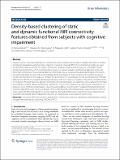| dc.contributor.author | Rangaprakash, D. | |
| dc.contributor.author | Odemuyiwa, Toluwanimi | |
| dc.contributor.author | Narayana Dutt, D. | |
| dc.contributor.author | Deshpande, Gopikrishna | |
| dc.date.accessioned | 2021-09-20T17:31:04Z | |
| dc.date.available | 2021-09-20T17:31:04Z | |
| dc.date.issued | 2020-11-26 | |
| dc.identifier.uri | https://hdl.handle.net/1721.1/131945 | |
| dc.description.abstract | Abstract
Various machine-learning classification techniques have been employed previously to classify brain states in healthy and disease populations using functional magnetic resonance imaging (fMRI). These methods generally use supervised classifiers that are sensitive to outliers and require labeling of training data to generate a predictive model. Density-based clustering, which overcomes these issues, is a popular unsupervised learning approach whose utility for high-dimensional neuroimaging data has not been previously evaluated. Its advantages include insensitivity to outliers and ability to work with unlabeled data. Unlike the popular k-means clustering, the number of clusters need not be specified. In this study, we compare the performance of two popular density-based clustering methods, DBSCAN and OPTICS, in accurately identifying individuals with three stages of cognitive impairment, including Alzheimer’s disease. We used static and dynamic functional connectivity features for clustering, which captures the strength and temporal variation of brain connectivity respectively. To assess the robustness of clustering to noise/outliers, we propose a novel method called recursive-clustering using additive-noise (R-CLAN). Results demonstrated that both clustering algorithms were effective, although OPTICS with dynamic connectivity features outperformed in terms of cluster purity (95.46%) and robustness to noise/outliers. This study demonstrates that density-based clustering can accurately and robustly identify diagnostic classes in an unsupervised way using brain connectivity. | en_US |
| dc.publisher | Springer Berlin Heidelberg | en_US |
| dc.relation.isversionof | https://doi.org/10.1186/s40708-020-00120-2 | en_US |
| dc.rights | Creative Commons Attribution | en_US |
| dc.rights.uri | https://creativecommons.org/licenses/by/4.0/ | en_US |
| dc.source | Springer Berlin Heidelberg | en_US |
| dc.title | Density-based clustering of static and dynamic functional MRI connectivity features obtained from subjects with cognitive impairment | en_US |
| dc.type | Article | en_US |
| dc.identifier.citation | Brain Informatics. 2020 Nov 26;7(1):19 | en_US |
| dc.contributor.department | Harvard University--MIT Division of Health Sciences and Technology | |
| dc.identifier.mitlicense | PUBLISHER_CC | |
| dc.eprint.version | Final published version | en_US |
| dc.type.uri | http://purl.org/eprint/type/JournalArticle | en_US |
| eprint.status | http://purl.org/eprint/status/PeerReviewed | en_US |
| dc.date.updated | 2020-11-29T04:22:30Z | |
| dc.language.rfc3066 | en | |
| dc.rights.holder | The Author(s) | |
| dspace.embargo.terms | N | |
| dspace.date.submission | 2020-11-29T04:22:30Z | |
| mit.license | PUBLISHER_CC | |
| mit.metadata.status | Authority Work and Publication Information Needed | |
